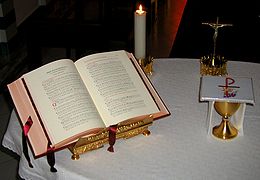How Spouses Can Live the Mass Together
 The poor remodeler, he was so uncomfortable that I thought he might break into a sweat. In fact, he might already have been sweating, but I dared not look too closely, lest my scrutiny escalate his discomfort. He’d come to bid on our kitchen reconstruction and walked into more than he’d bargained for. However, the job wasn’t the problem; it was our prayer corner that had him freaked out.
The poor remodeler, he was so uncomfortable that I thought he might break into a sweat. In fact, he might already have been sweating, but I dared not look too closely, lest my scrutiny escalate his discomfort. He’d come to bid on our kitchen reconstruction and walked into more than he’d bargained for. However, the job wasn’t the problem; it was our prayer corner that had him freaked out.
We have a prayer corner, which we call a home shrine in the tradition of the Schoenstatt Movement to enthrone the Blessed Mother in our homes. It’s placed in a prominent position in our open-concept home and has many of the symbols and sacramentals of a real church. It’s the center of our lives and because we’re around it all the time, it’s a normal part of our household – at least to us. Apparently, it wasn’t at all normal for the remodeler. He stopped talking mid-sentence when he entered the house and gave the home shrine a long, horrified stare. I was tempted to briefly explain our tradition, but I sensed that he wouldn’t be open to it. Rather, I decided to be very cool about it and let him have his space. I offered him a seat, and he haltingly accepted. He was sure to sit as far away from the home shrine as possible, and twisted himself so he’d be facing completely away from it. He couldn’t have been comfortable. I tried desperately not to smirk.
Granted, the remodeler may not have been Christian or perhaps he had a bad religious experience earlier in his life that caused his aversion to our devotion. If that’s the case either way, I feel sorry for him and pray that one day he’ll be able to open his heart to Christ. Still, his behavior reminds me of the way many of us live our marriages: any blatant demonstration of piety seems out of place and uncomfortable.
In fact, what our marriages need to be is a constant display of religiosity with a marked openness to the in-break of the divine at every moment. Our married life should be a reflection and continuation of holy Mass. During Mass, we offer sacrifice with Christ to the heavenly Father, we become intimately united with Christ and each other, and we receive life-giving grace and strength. In Mass, the Father is the center of all, as he should be in the rest of our married life. Every aspect of our day (yes, even the most private ones) should be a reenactment of the offertory, consecration, and communion of Mass. All that we have, are, and do, we offer to the heavenly Father. All that we have, are, and do is consecrated to him and thus made holy. Everything we have, are, and do becomes a means of unity with him and with each other.
Not all of us can attend Mass every day, but we can begin our days by spiritually attending Mass through prayer and spiritual communion. We can recall the offertory, consecration, and Communion of the Mass and communicate spiritually offering and consecrating ourselves, our spouses, and our marriage, including all that we’ll say and do for the rest of that day. Perhaps we can stop here or there during the day to re-offer, re-consecrate, and re-communicate. This can be done quite simply, with a brief, spontaneous prayer such as, “Father in heaven, we offer all we do and say today as spouses to you, please accept it. We consecrate all we do and say as spouses to you, please bless it. We ask you to unite with us throughout this day and grant us grace and strength for our marriage. Amen.” In this way, our marriages become a holy, sacrificial union that gives glory to God.
At first, this level of devotion may seem out of place and uncomfortable – indeed, we may be like the remodeler who twisted himself into knots to avoid an open show of devotion. But if we’re serious about striving, the discomfort will melt away and be replaced by genuine joy and fulfillment. The more we practice, the easier it will be and the more normal it will seem. Eventually, it will become an integral part of our lives.
This article originally appeared on FathersforGood.org, a website of the Knights of Columbus.

